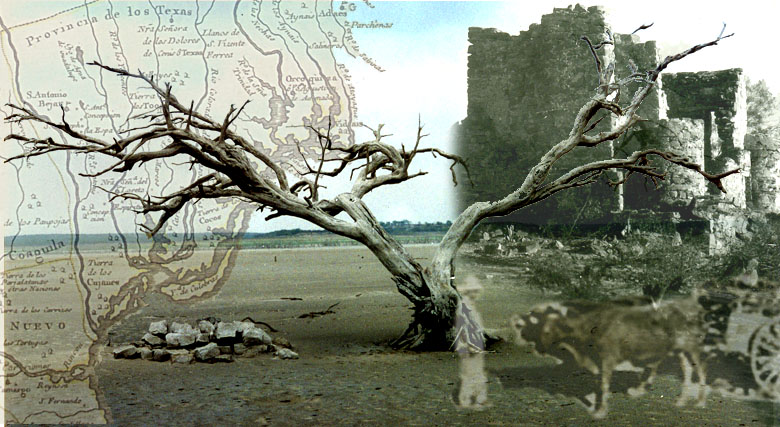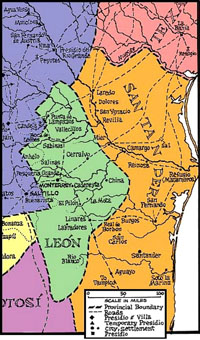
Area of Nuevo Santander. Adapted from map
by Jack Jackson.

|
 =Image can be enlarged =Image can be enlarged
|
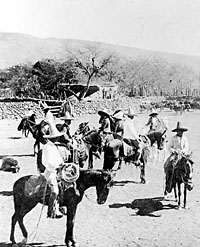
Mexican cowboys branding cattle in south Texas, early 1900s. The roots of the cattle industry, and Texas' rich ranching heritage, can be traced back to Spanish Colonial days. Courtesy Texas State Library and Archives Commission.  |
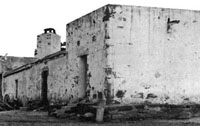
Because of the continual threat of raids by hostile Indians, many of the early ranch homes were built as fortress-like compounds. Shown is the Trevino fort constructed around 1820 at San Igncinacio, south of Laredo, Texas. This National Historic Landmark still stands, and the complex is open to the public. Historic American Buildings Survey Photo, circa 1920.  |
|
Throughout the eighteenth century, the Spanish made expeditions
into the area we now call Texas to set up missions and presidios
(military forts). They were designed to convert the native inhabitants
to Christianity and to maintain a presence on the land they claimed
for Spain. San Antonio also became an administrative center for
the area, growing into a town that housed military leaders and government
officials as well as artisans, ranchers, missionaries, Native Americans,
slaves, and servants. However, before the mid-eighteenth century,
there were no Spanish settlements that were made up of just civilian
families who made a living off the land. That was soon to change.
In 1748, José de Escandón led a Spanish
expedition to colonize the Province of Nuevo Santander. This was
a portion of land uninhabited by the Spanish at the time. Located northeast
of Nuevo Leon along a portion of the Gulf of Mexico, it incorporated
lands between the Nueces River and the present-day boundary of Tampico, and included the southernmost portion of the Rio Grande. The expedition was to
be the first civilian-only settlement in Texas. The colonists were
farmers and ranchers, who moved north to try to build a new and
better life. The techniques and equipment they brought with them
became the standard for ranching operations in Texas and the West
well into the twentieth century.
Although stories of these early ranchers have been
passed down through the centuries to their descendants, relatively
little has been written or published for a wide audience. There
is a wealth of historic records in small archives such as courthouses
and family collections, but these handwritten documents are often
difficult to read and translate.
The area's first settlers, however, did leave tangible
information in the ground, some of which was recovered and studied by archeologists. For example, archeologists from the University of Texas
managed to excavate one of the rancho sites in 1950 and 1951 before it was completely
destroyed by the creation of Falcon Reservoir. From the structural
ruins and household debris emerged a poignant glimpse of day-to-day
life in the Spanish Colonial borderlands. It was the first rancho
excavated in Texas.
The following sections on the Falcon Reservoir area trace the area's settlement, with a detailed look at the Leal rancho and the information recovered from archeological investigations. We also look at the area after the innundation of Falcon Reservoir and the toll taken on on archeological sites
as the waters periodically rise and fall.
This exhibit is the first of several in the region we hope to provide on Texas
Beyond History. In the future, we hope to trace personal stories of the inhabitants through oral histories and explore the rich
architectural legacy that still survives in the region's small towns
and rural areas. We will also look back at some of the structures
that have been lost to time and modern development.
|
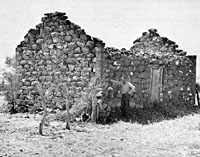
Stone structures from eighteenth-century
ranchos stood in ghostly ruin before they were submerged beneath
the waters of Falcon Reservoir in the 1950s. Before the inundation,
archeologists documented several sites, capturing much information
that otherwise would have been lost. Photo by Jack Humphreys,
from TARL archives.  |
|
The techniques and equipment the colonists brought with them became
the standard for ranching operations in Texas and the West
well into the twentieth century.
|
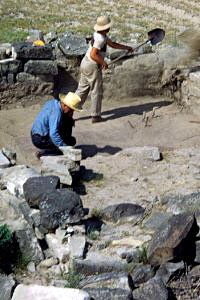
Archeologists from the University of Texas at Austin unearth the floor of a Spanish Colonial ranch house in Starr County. This excavation and others conducted during the early 1950s provided a wealth of information about early ranch life on the border. TARL Archives.  |
|
